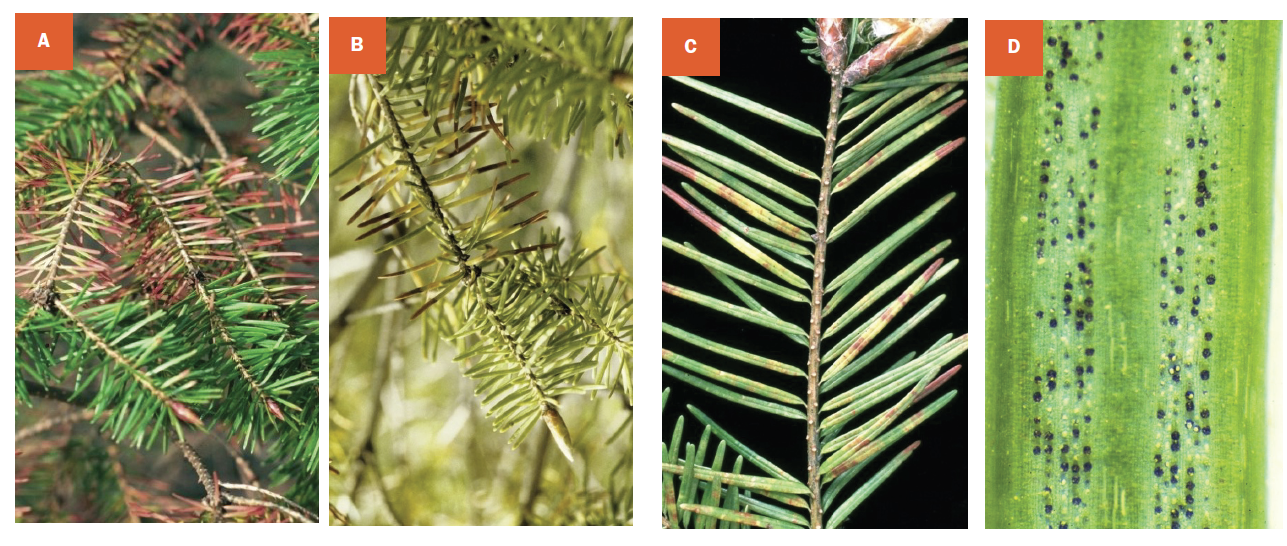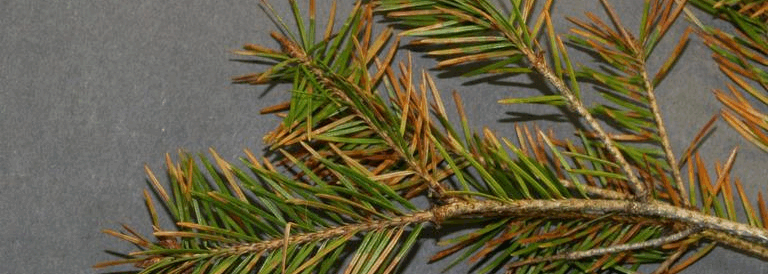What is Swiss Needle Cast Disease?
Swiss needle cast is a fungal infection that only Douglas-fir trees (Pseudotsuga menziesii) can contract. It is caused by fungi–Nothophaeocryptopus gaeumannii that was first described in the 1920s in Switzerland on imported North American Douglas-firs.
New needles are infected by the fungus in wet spring weather and grow unnoticed in the needle. It later forms small black fruiting bodies which block the breathing pores (stomata). This inhibits normal photosynthesis which makes the needles turn yellow and fall in a year or two rather than in four.
The disease is worst along the damp Pacific coast, cutting Douglas-fir growth by up to half. Among other things, the disease changes the structure of forests, causes the decline of carbon storage, and affects wildlife.

Oregon State University estimates that more than 520,000 acres are already impacted by timber losses of approximately 230 million dollars every year.
Swiss Needle Cast Douglas Fir – How the Disease Works
Infection Process
The fungus also produces spores during rainy or foggy seasons in the spring (April-June). These spores fall on recently emerged soft needles. The fungus then penetrates the surface of the needle and starts to grow within the tissue without producing immediate damage.
This hidden, or endophytic, phase can last nine to twelve months. The fungus gradually spreads to the inner areas of the needle as it grows. Then in the next spring it starts producing small black fruiting bodies known as the pseudothecia which in turn will create new spores and bring the circle of life back.
Physical Damage Mechanism
The black pseudothecia appear in neat rows along the lower surface of the needles. Every fruiting body covers a stoma, which is a tiny aperture that the tree uses to release water vapor and exchange gases.
In cases when the number of stomata being plugged is high, then the needle will fail to absorb a sufficient amount of carbon dioxide to perform photosynthesis.
Studies have shown that CO₂ assimilation can drop by 30 to 50% in heavily infected needles. The needles become weak, yellow and drop prematurely without enough energy production. Infected trees whose infections recur repeatedly shed most of their older foliage leaving thin crowns and fewer branches.
This incessant defoliation over a period of several years decelerates growth in the height and diameter, impairs the quality of timber and exposes the trees to other stressors like drought or insect attack.
Swiss Needle Cast Symptoms, Identification and Diagnosis
Early Stage Symptoms (Year 1-2)
During the first year/two of infection, infected trees exhibit low-grade yellowing/chlorosis of the older needles. The discoloration normally appears in the lower and the interior branches, whereas new growths might still remain healthy. Needles that are still alive start to lose their usual green shiny appearance and trees can have a dull shade or uneven shade. At this stage, needle drop is limited but retention already starts to shorten.
Advanced Stage Symptoms (Year 3+)
As the disease advances, the tree’s crown becomes noticeably thin and open. Most of the older needles fall off, leaving only the youngest one or two years of growth. Branches look sparse and the overall shape of the tree becomes “see-through.” Growth slows down, with shorter needles, reduced branch extension, and smaller annual rings.

Black fruiting bodies called pseudothecia may be visible on the underside of retained needles, often arranged in neat rows. (Image Credits: Bruce Watt)
Diagnostic Confirmation
To confirm Swiss needle cast, collect a few affected needles and examine them with a hand lens or under a microscope at about 10x magnification. The pseudothecia appear as tiny black dots lined along the stomatal rows.
Laboratory testing can provide final confirmation by identifying Nothophaeocryptopus gaeumannii within the needle tissue. Counting the number of retained needle years also helps. Healthy Douglas-fir trees typically hold three to four years of foliage, while infected trees hold only one or two.
Environmental Factors and Disease Spread
Climate Factors Driving Disease
The greatest contribution to infection is made by springtime leaf wetness. Prolonged rain or fog in April to June enables the bacteria spores of the fungi to germinate and infect young needles.
Survive and spread have also been driven up by warmer winters that are increasing approximately 0.2 to 0.4 °C each decade since the 1970s. Overall spring precipitation increased by almost a centimeter per decade in most locations, which prolongs the infection period and severity of outbreaks.
Geographic Risk Patterns
The most severely damaged forests are in the 30 miles of the Pacific Ocean particularly in coastal Oregon and Washington, under 1,000 feet of elevation.
The further one is the less disease pressure. The foothills and inland valleys are moderate with higher and windier situations not largely affected.
Due to climate changes, which alter the distribution of rainfall and increase the temperatures, the disease now infects safe inland areas, spreading the range of the disease even further east.
Transmission and Spread
The Swiss needle-cast is spread by wind and rain splash which transfers spores tree-to-tree. The majority of the infections are localized in the same stand although there can be a short travel of spores to other plantations.
Thick forests that have low air circulation have high humidity and this results in the perfect microclimate that the infection thrives in. Another way of transmitting the disease is by carrying infected nursery stock which introduces the fungus to already infected areas.
What is Swiss Needle Cast Treatment? – Management Strategies
Cultural Management Practices
This is achieved through enhancing air circulation. The trees ought to be spaced far apart to curb humidity and wetness of the leaves. This is achieved by pruning lower branches which facilitate greater air circulation and sunlight penetration thus drying the foliage quicker following rain.
Douglas-fir should not be planted in moist valleys with low and foggy climates where moisture is stagnant. Irrigation is to be kept to a minimum during spring when the needles are the most susceptible and any infected debris must also be removed and disposed of correctly.
Fungicide Treatment Protocols
New infections can be prevented by the use of protective fungicides (like chlorothalonil or mancozeb), provided it is used in a timely.
The initial spray is to be done in late May when all the new needles are full and thereafter a second spray is to be done four to six weeks afterward. The new foliage is the only one that is safeguarded and therefore there is a need to repeat the treatment in annual cycles in order to ensure permanence.
Great coverage in the canopy is also necessary and dry weather of at least 24 hours after application is necessary so that the fungicide adheres properly.
Treatment Limitations and Realities
Fungicide treatments are practical mainly for small ornamental or landscape Douglas-fir trees under 30 feet tall. The cost and difficulty of spraying large forest stands make chemical control uneconomical on a commercial scale. This is because each tree can cost between 150 to 400 dollars each year to treat based on the size and accessibility.

In the case of timber production, the management tends more to target resistant varieties, superior spacing and less favorable planting sites to the disease.
Swiss Needle Cast Fungicide Options and Application
Primary Fungicide Options
The most confident products in the management of Swiss needle cast are based on chlorothalonil like Daconil and Bravo. They have the capacity to reduce disease levels by 40-60% when utilized well.
Fungicides based on copper such as Bordeaux mixture (8-100 combination of lime, copper sulfate and water) and copper hydroxide preparations, have a reduction of 25-40% but are less predictable.
They are designed to be used in organic or environmentally sensitive environments. Mancozeb offers moderate protection of 30-40%, principally the prevention of new infections on emerging needles.
Application Best Practices
Application of fungicides should be done at the end of May when the new needles of the new plant are only four or five weeks old and another spray should be undertaken after four or five weeks.
The coverage of the canopy is essential because the uncovered areas will be infected as well. Painting on dry days and without a forecast of rain within 24 hours will be appropriate to ensure that it adheres well. There should be adequate spray pressure to ensure that it is evenly distributed.
Always take instructions on product labels on how to take them and wear protective equipment, including gloves, goggles, and respirators. Large trees with considerable density should be applied by professional applicators to ensure that it covers all parts of the tree and is also safe.
Can a Tree Recover from Swiss Needle Cast?
Recovery Potential by Severity
- Mild infections, where only 10-30% of the crown is defoliated, typically recover within two to three years when proper treatment and care are maintained. These trees would be able to provide regular foliage coverage with yearly fungicidal coverage in addition to better growing conditions.
- Moderate infections, which involve 30-50% loss of needles, take three to five years of continuous treatment. It has a reduced success rate of approximately half, and regrowth is also small.
- Serious infections of over 50% loss of the crowns are not likely to heal completely. Trees do not really get better even with treatment, only 10-20%.

Removal and replacement with resistant species can sometimes be a feasible solution to such cases particularly in high-pressure coastal regions.
Supporting Tree Recovery
Promotion of recovery entails alleviation of stress on infected trees. Watering should also be done frequently, especially in dry summer seasons of between one inch per week, to keep it vigorous. Work out a moderate, slow-acting fertilizer at the beginning of the spring season to stimulate the growth of new needles. Keep on using fungicides to cover new leaves and keep checking trees in season to see their color, density and growth.
Prevention Strategies – Avoiding Swiss Needle Cast
Species Selection Strategies
Trees grown with inland sources of seeds are less susceptible to infection compared to the trees of the coast. In coastal zones where there is a lot of risk, other evergreen trees like western red cedar,noble fir,or western hemlock are better to plant; they are more tolerant.
Other breeding programs are working on breeding Douglas-fir seedlings that are genetically resistant to Swiss needle cast, as a long-term solution to the long term sustainability of replanting.
Site Selection Criteria
Select planting locations higher than 1,000 feet or in dry and windy spots that dry following a pour.
- Valleys: Do not use valley bottoms or shaded slopes and areas where the needles are long and damp. Planting trees at a minimum of 12 feet ensures that there is better air circulation, humidity is lowered and the spread of fungus is minimized so that the foliage will stay longer and healthier.
Nursery Stock Considerations
Nursery trees should be carefully inspected before planting by checking for the symptoms which include yellow needles or small black dots at the underside.
The nurseries to purchase are always certified to be disease-free and adhere to the standards of sanitation and inspection.
It is recommended not to plant or relocate Douglas-fir inventory along the coastal region to new areas where the disease did not exist previously.
Long-term Planning
Promote the local biodiversity as opposed to the Douglas-fir monocultures. Measurably check on the current trees to identify early signs and also change planting schemes with the change in the local weather pattern.
Future planning will be of benefit in ensuring the stability of forests as temperatures and rainfall patterns continue to vary.
Forest Management and Commercial Forestry Implications
Commercial Impact Assessment
The height and diameter of infected stands increase by half and result in thinner logs and smaller harvest volumes.
The wood itself does not always go to waste, as it is smaller and has a longer harvesting period, which makes the production less efficient.
The resulting losses to the timber companies are losses in revenue and the decreased sequestration of carbon in the affected landscapes.
Forest Management Adaptations
To minimize the economic loss, managers are increasing planting strategies species composition and revising the strategies.
Douglas-fir together with western hemlock or red cedar enhances resilience with the latter. Such new rotations are frequently reduced to 30-40 years, where harvest can be obtained before the disease has a devastating effect on the growth.

In susceptible regions, the direction of planting is moving inland or uphill where the spread is slower due to a colder and drier climate.
Research and Monitoring
The Swiss Needle Cast Cooperative at Oregon State University leads ongoing research to track disease trends and improve management. The USDA Forest Service conducts annual aerial surveys that map the area of the defoliation process and keep an eye on the new areas of outbreak.
Genetic resistance and fungicide performance studies and climate adaptation studies are long-term studies, which are used to inform future forestry practice in the region.
Climate Change and Future Disease Projections
Climate Trend Analysis
Winter and spring temperatures in the area have also been soaring every decade by 0.2 to 0.4 °C, and the rainfall in the spring has risen by up to 1.5 centimeters per decade.
The fungus is easy to infect because of the combination of mild winters and continuous fog that keeps the needles wet.
These moist conditions are predicted through climate models to become even more favorable, which will provide an additional 25-40% more favorable climates in support of the Swiss needle cast infection.
Future Projections
The rise in temperatures will cause the disease to spread further into the inland regions and higher altitudes in the upcoming decades.
There is a risk of chronic and severely infected coastal forests, and a reduction in the productivity of timber in the traditional Douglas-fir areas can drop drastically. Certain places previously deemed to be appropriate for Douglas-fir might not provide healthy growth hence a change in planting and rotation plans is necessitated.
Adaptation Strategies
The adaptive strategies that the future management will depend on are assisted migration with sources of seeds from warmer, drier regions as well as shifting to more climate-resistant species.
It will be critical to expand disease surveillance systems and ongoing research on genetic resistance. The forestry plans can also be modified according to the future climate conditions to invest in long-term research and preserve the Pacific Northwest forests against increasing Swiss needle casts.







